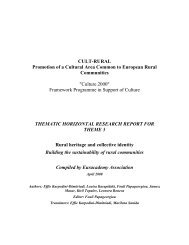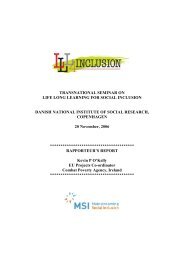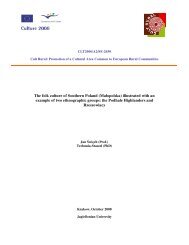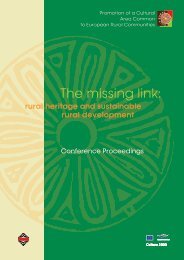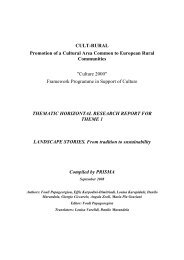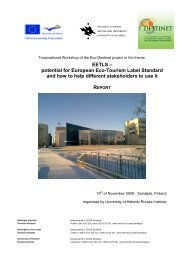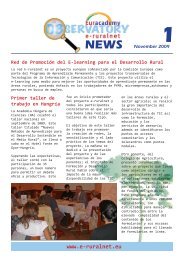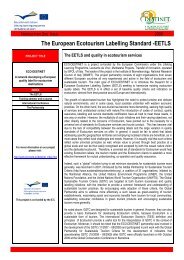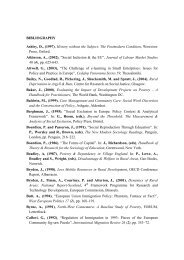ÐÐ¾Ð´Ð°Ñ Ð¿Ð¾ изложбаÑа - cult rural - Prisma
ÐÐ¾Ð´Ð°Ñ Ð¿Ð¾ изложбаÑа - cult rural - Prisma
ÐÐ¾Ð´Ð°Ñ Ð¿Ð¾ изложбаÑа - cult rural - Prisma
Create successful ePaper yourself
Turn your PDF publications into a flip-book with our unique Google optimized e-Paper software.
SYMBOLISMS OF FERTILITY AND REBIRTH<br />
OF NATURE<br />
share the festive table, exchange ritual breads (during the last century they<br />
were generally called “kozunaks”) and dyed eggs. A traditional game is played<br />
where each player hits the other player’s egg with his own. This is known as<br />
“egg tapping” and the holder of the last intact egg will be the healthiest person<br />
throughout the year. On that day, people greet themselves with “Christ has risen”<br />
and get the response “He truly has risen”.<br />
HARVEST RITES<br />
In Greece the principal traditional <strong>rural</strong> customs were – and in many cases still<br />
are- closely related with agri<strong>cult</strong>ural activities and rituals usually linked to a feast<br />
day, which par excellence aimed to guarantee the survival of people. Combining<br />
pagan and Christian practices, most of them have been preserved across the<br />
ages as having a great signifi cance for securing the rendering of the fields and in<br />
consequence a good year for the family and the community.<br />
For the farmers the way earth is going to receive ploughing and harvesting is<br />
considered as very important. For this reason farmers offered the first fruits<br />
(6th of August) to the church to be blessed (especially in northern Greece and<br />
Thrace). Many symbolic actions are related with sowing; among them is the<br />
Feast of Seeds, known with the ancient name panspermia, which is celebrated<br />
on the feast day of the Virgin Mary (Presentation of the Virgin, 21 November),<br />
called Messosporitissa “protector of grain in the middle of sowing period”. During<br />
this day in many <strong>rural</strong> areas, people used to eat, as a main meal, a combination<br />
of boiled cereals and vegetables, and to share a small portion with neighbours in<br />
order to guarantee the abundance of plants.<br />
Among the symbolic actions linked with the cycle of cereals and of the corn, it<br />
is worth noting the sowers’ habit of tying the last ears of corn in a nice bouquet<br />
with different forms (comb, cross etc), which sometimes they hang around the<br />
iconostasis of the house, the place where they usually keep the icons, or they<br />
hang it from the ceiling. In some regions (e.g in the island of Karpathos) they<br />
leave in the fields some ears of the corns, while tracing around them a magic<br />
circle with a sickle.<br />
In Poland, especially in eastern Małopolska, the celebration of a solemn end<br />
of harvest was called “wieńcowiny” or “okrężne”. Recently, and popular in the<br />
whole country, the term “dożynki” has been adopted. The rite originating from<br />
pagan traditions related to the <strong>cult</strong> of fertility deities started after the completion<br />
of the most important field works, mainly at the turn of August and September.<br />
It could be also held a little earlier on 15th August - the day of Assumption of St.<br />
Virgin Mary, called in Polish <strong>cult</strong>ure the God’s Mother “Zielnej” holiday. In this role<br />
the God’s Mother was considered to be the patron of soil and its crops: herbs,<br />
flowers, cereal and fruit.<br />
The “dożynki” rite started on the day of completing work on cutting the cereal.<br />
The harvesters produced a sheaf – “snopek żniwny” decorated with flowers, and<br />
a wreath of cereal ears, which they gave to the host and the hostess. Thanking<br />
for the hard work, the host invited the harvesters to an evening party. On the field<br />
a small amount of the uncut cereal was left, the so-called “przepiórka”. It was<br />
52. Painted eggs, Bulgaria<br />
53. Easter ritual bread, Bulgaria<br />
28<br />
52.<br />
53.<br />
54. Rubbing the children faces with red egg<br />
for health on Easter, Bulgaria<br />
55. Festive straw decoration, Bulgaria




